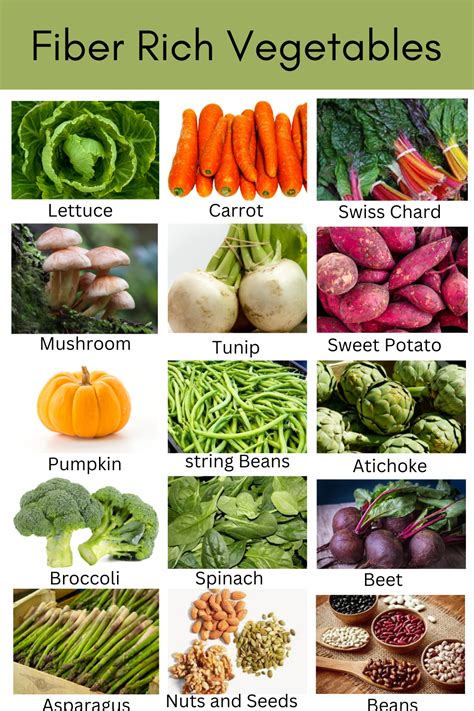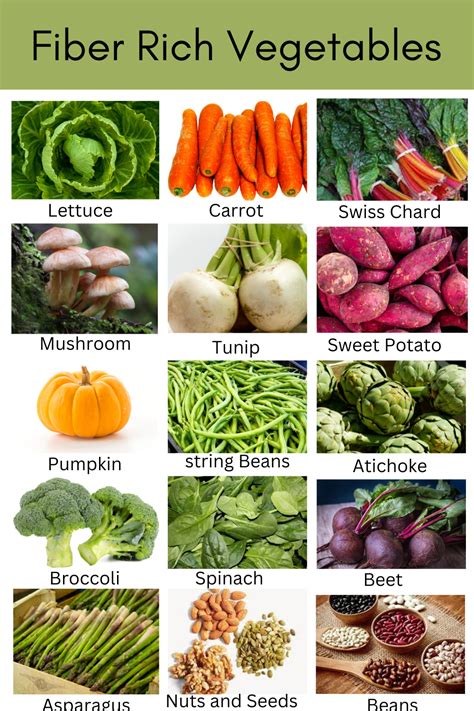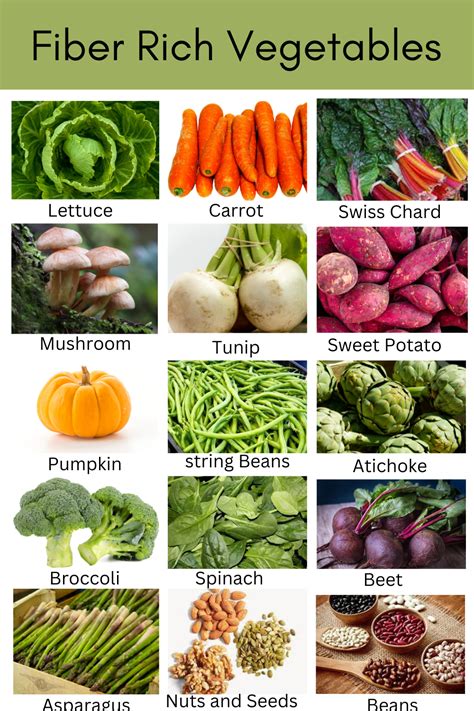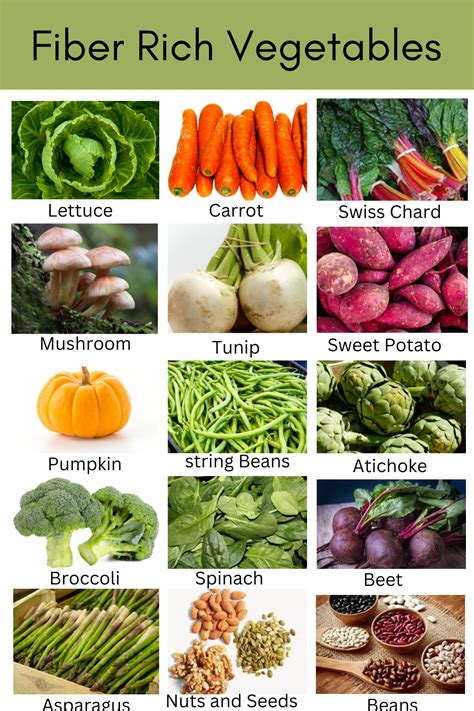Intro
Boost digestion with 5 high fiber vegetables, including broccoli, carrots, and Brussels sprouts, rich in dietary fiber, vitamins, and minerals, supporting healthy gut bacteria and weight management.
Eating a diet rich in fiber has numerous health benefits, including promoting digestive health, supporting healthy blood sugar levels, and even aiding in weight management. One of the best ways to increase your fiber intake is by incorporating high fiber vegetables into your meals. With so many delicious and nutritious options to choose from, it's easy to get started. From leafy greens to crunchy cruciferous vegetables, there's a high fiber vegetable to suit every taste and dietary need. In this article, we'll explore the importance of fiber in our diets and highlight five high fiber vegetables that you should consider adding to your shopping list.
A high fiber diet can have a significant impact on our overall health and wellbeing. Fiber helps to regulate bowel movements, preventing constipation and diverticulitis, and can even help to lower cholesterol levels and reduce the risk of heart disease. Additionally, fiber-rich foods tend to be more filling, making them a great choice for those trying to manage their weight. With the average adult consuming less than half of the daily recommended intake of fiber, it's clear that many of us could benefit from incorporating more high fiber foods into our diets.
High fiber vegetables are some of the richest sources of dietary fiber, and they're also packed with vitamins, minerals, and antioxidants. These nutrients work together to provide a range of health benefits, from supporting healthy cell growth to protecting against chronic diseases. By making a few simple changes to your diet, such as swapping out low-fiber vegetables for high fiber alternatives, you can take a significant step towards improving your overall health and wellbeing. Whether you're looking to boost your energy levels, support healthy digestion, or simply feel fuller for longer, high fiber vegetables are a great place to start.
Introduction to High Fiber Vegetables

Benefits of High Fiber Vegetables
Some of the key benefits of high fiber vegetables include: * Promoting regular bowel movements and preventing constipation * Supporting healthy blood sugar levels and reducing the risk of diabetes * Aiding in weight management by providing a feeling of fullness and satisfaction * Lowering cholesterol levels and reducing the risk of heart disease * Providing a rich source of essential vitamins, minerals, and antioxidants5 High Fiber Vegetables to Add to Your Diet

- Artichokes: With a whopping 10 grams of fiber per medium-sized artichoke, these tasty vegetables are a great way to boost your fiber intake. Artichokes are also rich in vitamins and minerals, including vitamin C, vitamin K, and potassium.
- Brussels Sprouts: These small, cruciferous vegetables are a rich source of fiber, with a single serving providing around 5 grams. Brussels sprouts are also packed with vitamins and antioxidants, making them a great addition to a healthy diet.
- Carrots: While they're often thought of as a low-fiber vegetable, carrots are actually a great source of dietary fiber. With around 3 grams of fiber per medium-sized carrot, they're a great snack to munch on throughout the day.
- Sweet Potatoes: These delicious, orange-colored vegetables are a rich source of fiber, with a single medium-sized sweet potato providing around 4 grams. Sweet potatoes are also packed with vitamins and minerals, including vitamin A and potassium.
- Peas: With around 9 grams of fiber per cup, peas are one of the highest fiber vegetables on our list. They're also low in calories and rich in protein, making them a great addition to a weight loss diet.
Adding High Fiber Vegetables to Your Meals
Adding high fiber vegetables to your meals is easier than you think. Here are some tips to get you started: * Start your day with a high fiber breakfast, such as oatmeal with fruit and nuts or scrambled eggs with spinach and whole wheat toast. * Add high fiber vegetables to your favorite soups and stews, such as lentil soup or vegetable stew. * Use high fiber vegetables as a topping for salads or as a side dish for your favorite meals. * Try roasting or grilling high fiber vegetables as a healthy and delicious alternative to fried foods.Cooking with High Fiber Vegetables

High Fiber Vegetable Recipes
Here are some delicious and healthy high fiber vegetable recipes to try: * Roasted Brussels sprouts with sweet potatoes and carrots * Grilled artichokes with lemon and garlic * Sauteed peas with garlic and ginger * Baked sweet potato fries with roasted vegetables * Lentil soup with kale and quinoaConclusion and Next Steps

We hope this article has inspired you to add more high fiber vegetables to your diet. If you have any questions or comments, please don't hesitate to reach out. We'd love to hear from you and help you on your journey to a healthier, happier you.
What are the benefits of eating high fiber vegetables?
+Eating high fiber vegetables can help promote regular bowel movements, support healthy blood sugar levels, and even aid in weight management. They're also rich in essential vitamins, minerals, and antioxidants, making them a great addition to a healthy diet.
How can I add more high fiber vegetables to my diet?
+Adding more high fiber vegetables to your diet is easier than you think. Try starting your day with a high fiber breakfast, adding high fiber vegetables to your favorite soups and stews, or using them as a topping for salads or as a side dish for your favorite meals.
What are some high fiber vegetable recipes I can try?
+There are many delicious and healthy high fiber vegetable recipes to try. Some ideas include roasted Brussels sprouts with sweet potatoes and carrots, grilled artichokes with lemon and garlic, and sauteed peas with garlic and ginger. You can also try adding high fiber vegetables to your favorite soups and stews, or using them as a topping for salads or as a side dish for your favorite meals.
